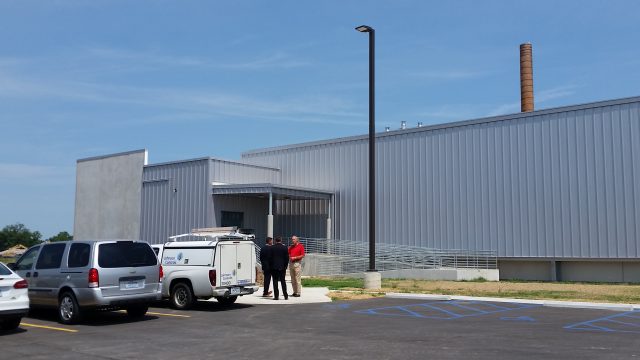FULTON, Mo. – Gov. Jay Nixon toured the first stage of the rebuild of the Fulton State Hospital Thursday morning, which has been standing since 1851.
The rebuild of the psychiatric hospital will feature 300 beds for patients with severe mental illnesses when construction is completed later this year. Those committed to Fulton by the courts are done so to evaluate and treat them after they have committed a crime in relation to their illness or if they have assaulted staff or other patients at Missouri’s other psychiatric institutions.
The Fulton State Hospital is the only high-security psychiatric hospital in the state, and the oldest of its kind West of the Mississippi River.
Nixon toured the first completed part of the facility known as the Energy Control Center and Services Building, which will serve mainly as an administrative and logistics-focused building. It houses two emergency generators and will host the maintenance shop, the emergency command center, the communications hubs, computer and IT services as well as the kitchen.

“The replacement of the outdated and dangerous facility was long overdue, and the new state-of-the-art mental hospital will provide safer conditions that are more conducive to modern treatment for generations to come,” Nixon said in a statement.
Outside of the kitchen where Nixon spoke to members of the community and press, pictures of the previous building showed dilapidated facilities, including rotting, wooden cold storage doors crusted with ice and decades-old ovens that had clearly seen better days. Some of the buildings considered as part of the hospital campus looked every their pre-Civil War construction date.
Nixon pushed for the rebuild as early as 2011 and has made a direct appeal to treat mental health as a large part of his administration ever since the Newtown massacre in which a deranged gunman killed 26 people including 20 children at a Connecticut elementary school. In May 2014, legislative leaders and Nixon agreed on a budget that would allot money for the $211 million project. Later that year, the Office of Administration approved $92 million in bonds to begin paying for the construction.
A groundbreaking ceremony was held in Spring of 2015.
Although Rep. Travis Fitzwater, R-Holts Summit, was not in the General Assembly during that budget battle, he represents Fulton and believes that this construction project will mean a lot not only for the region, but the whole state.

“You’re talking about 300 clients at this facility that… are at their most significant crisis probably anybody in our society will ever deal with and to have a facilty that was created in 1851 finally be demolished in 2015 is of the utmost importance,” Fitzwater said. “Getting a facility that’s a safe environment for employees and clients, that’s safe for our community, that’s going to be a light on the hill for the mental health community.”
Fitzwater added that he would like to see more work done to benefit those suffering with mental health problems and supported Nixon’s call to do the same. In the same vein, Nixon thanked Fitzwater for his ongoing work on the problem, and credited Sen. Jeanie Riddle, R-Mokane, with her efforts as well although she could not attend the event.
Nixon noted that the bipartisanship that allowed for the construction of the new facility was more common than people believed.
“I think we agree on a lot more stuff than people think we do,” he said, adding that good policy is “not based on whether they ride a donkey or an elephant to Jeff City, but based on what is good for the state. I think ultimately projects like this that transcend the day-to-day politics, just requires education.”
“There isn’t really a partisan overlay to them. Everybody understood the need here.”








